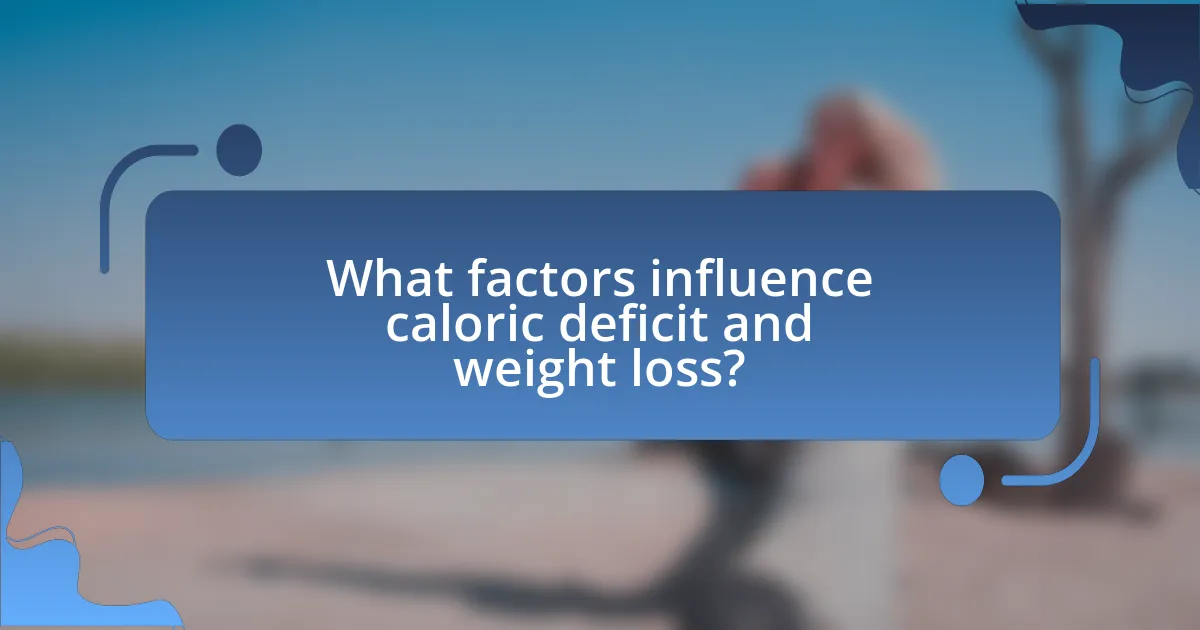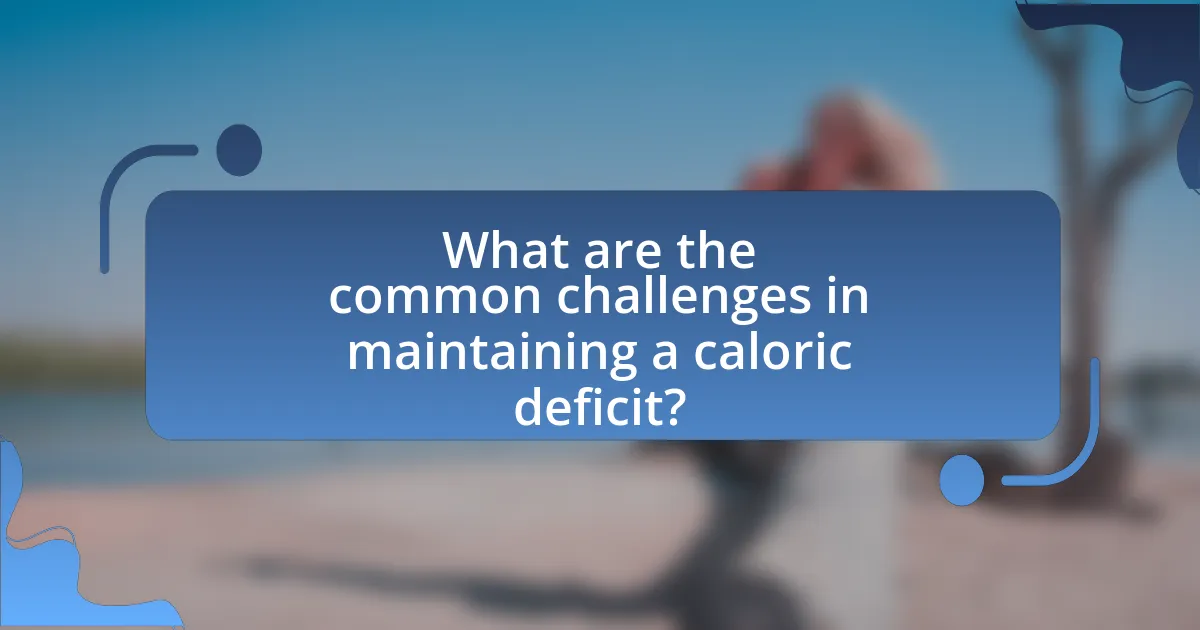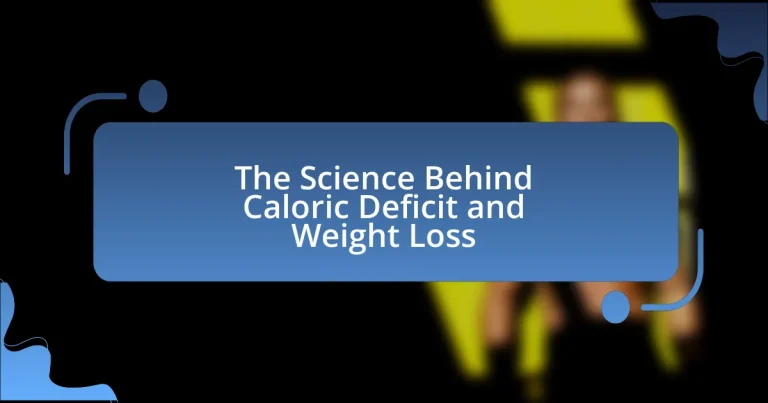The article focuses on the science behind caloric deficit and its role in weight loss. It explains that a caloric deficit occurs when calorie intake is less than calorie expenditure, leading to the utilization of stored fat for energy. Key physiological processes during a caloric deficit, such as lipolysis and metabolic adaptations, are discussed, along with the importance of understanding caloric deficit for effective weight management. The article also addresses factors influencing caloric deficit, common challenges in maintaining it, and practical strategies to support weight loss goals, including dietary choices, meal planning, and physical activity.

What is the Science Behind Caloric Deficit and Weight Loss?
A caloric deficit occurs when an individual consumes fewer calories than their body expends, leading to weight loss. This principle is grounded in the laws of thermodynamics, specifically the first law, which states that energy cannot be created or destroyed, only transformed. When the body is in a caloric deficit, it turns to stored energy, primarily fat, to meet its energy needs, resulting in weight loss. Research indicates that a deficit of approximately 500 to 1,000 calories per day can lead to a weight loss of about 1 to 2 pounds per week, which is considered a safe and sustainable rate (National Institutes of Health, 2013). This process involves metabolic adaptations, where the body may adjust its energy expenditure in response to prolonged caloric deficits, but the fundamental mechanism remains that a negative energy balance leads to weight loss.
How does a caloric deficit lead to weight loss?
A caloric deficit leads to weight loss by causing the body to utilize stored fat for energy when it consumes fewer calories than it expends. This energy imbalance forces the body to tap into its fat reserves, resulting in a decrease in body weight over time. Research indicates that a deficit of approximately 3,500 calories is associated with a loss of about one pound of body fat, highlighting the direct relationship between caloric intake and weight management.
What physiological processes occur during a caloric deficit?
During a caloric deficit, the body undergoes several physiological processes aimed at maintaining energy balance. Primarily, the body shifts from using glucose as its main energy source to utilizing stored fat through lipolysis, where triglycerides are broken down into free fatty acids and glycerol. This process is facilitated by hormones such as glucagon and epinephrine, which increase during periods of low energy intake.
Additionally, muscle protein breakdown occurs to provide amino acids for energy and to support essential bodily functions, particularly when carbohydrate stores are low. This catabolic state is regulated by cortisol, which increases in response to stress and low energy availability.
Furthermore, metabolic adaptations take place, including a decrease in resting metabolic rate as the body conserves energy. Research indicates that prolonged caloric deficits can lead to hormonal changes, such as reduced levels of leptin and increased levels of ghrelin, which influence hunger and satiety signals. These adaptations are crucial for survival, allowing the body to function despite reduced energy intake.
How does the body utilize stored energy during weight loss?
The body utilizes stored energy during weight loss primarily by converting fat reserves into usable energy through a process called lipolysis. During a caloric deficit, when energy intake is less than energy expenditure, the body triggers hormonal changes that promote the breakdown of triglycerides stored in adipose tissue. This process releases fatty acids into the bloodstream, which are then transported to various tissues, including muscle and liver, where they undergo beta-oxidation to produce ATP, the energy currency of cells. Research indicates that during prolonged caloric restriction, the body can derive up to 80% of its energy from fat stores, highlighting the efficiency of fat metabolism in weight loss scenarios.
Why is understanding caloric deficit important for weight management?
Understanding caloric deficit is crucial for weight management because it directly influences body weight regulation. A caloric deficit occurs when the number of calories consumed is less than the number of calories expended, leading to weight loss. Research indicates that maintaining a caloric deficit of approximately 500 to 1,000 calories per day can result in a safe weight loss of about 1 to 2 pounds per week, as recommended by the Centers for Disease Control and Prevention. This understanding allows individuals to create effective dietary and exercise plans tailored to their weight loss goals, ensuring that they achieve and maintain a healthy weight.
What role does caloric deficit play in different weight loss strategies?
Caloric deficit is essential in all weight loss strategies as it directly leads to weight reduction by ensuring that energy expenditure exceeds energy intake. This principle is foundational across various approaches, including low-carb diets, intermittent fasting, and calorie restriction, where the common goal is to create a negative energy balance. For instance, research published in the “American Journal of Clinical Nutrition” by Hall et al. (2016) demonstrates that a sustained caloric deficit results in weight loss regardless of the macronutrient composition of the diet. Thus, the role of caloric deficit is critical, as it is the primary mechanism through which weight loss occurs in diverse dietary frameworks.
How can misconceptions about caloric deficit affect weight loss efforts?
Misconceptions about caloric deficit can significantly hinder weight loss efforts by leading individuals to adopt ineffective or harmful dieting practices. For instance, the belief that extreme caloric restriction is necessary for weight loss can result in nutritional deficiencies and metabolic slowdown, ultimately making it harder to lose weight. Research indicates that a moderate caloric deficit, typically around 500 calories per day, is more sustainable and effective for long-term weight loss, as supported by the National Institutes of Health, which emphasizes balanced nutrition alongside caloric reduction. Additionally, misunderstandings about the role of macronutrients can cause individuals to overlook the importance of protein intake, which is crucial for preserving muscle mass during weight loss.

What factors influence caloric deficit and weight loss?
Caloric deficit and weight loss are influenced by several key factors, including dietary intake, physical activity, metabolic rate, and hormonal balance. Dietary intake directly affects the number of calories consumed; for weight loss to occur, calorie consumption must be lower than calorie expenditure. Physical activity increases energy expenditure, contributing to a greater caloric deficit. Metabolic rate, which varies among individuals, determines how efficiently the body burns calories at rest and during activity. Hormonal balance, particularly hormones like insulin, leptin, and ghrelin, plays a crucial role in regulating appetite and metabolism, impacting weight loss efforts. These factors collectively determine the effectiveness of achieving and maintaining a caloric deficit for weight loss.
How do individual metabolic rates affect caloric deficit?
Individual metabolic rates significantly influence caloric deficit by determining the number of calories a person burns at rest and during activity. A higher metabolic rate results in more calories burned, which can create a larger caloric deficit when combined with reduced caloric intake. For example, individuals with a basal metabolic rate (BMR) of 1,800 calories will require more calories to maintain their weight compared to those with a BMR of 1,400 calories. Consequently, if both individuals consume 1,500 calories, the first person will achieve a greater caloric deficit of 300 calories, while the second will only have a deficit of 100 calories. This difference in metabolic rates can be attributed to factors such as age, sex, muscle mass, and genetic predisposition, all of which affect how efficiently the body utilizes energy.
What is the relationship between basal metabolic rate and caloric needs?
Basal metabolic rate (BMR) directly influences caloric needs, as BMR represents the number of calories the body requires at rest to maintain essential physiological functions. This foundational metabolic rate accounts for approximately 60-75% of total daily energy expenditure, meaning that individuals with a higher BMR will generally have greater caloric needs to sustain their body functions. For instance, factors such as age, sex, weight, and muscle mass can affect BMR; thus, a younger person with more muscle mass will typically require more calories than an older person with less muscle mass. This relationship underscores the importance of calculating BMR when determining an individual’s caloric intake for weight maintenance, loss, or gain.
How do factors like age, gender, and muscle mass impact metabolism?
Age, gender, and muscle mass significantly impact metabolism by influencing the basal metabolic rate (BMR) and overall energy expenditure. As individuals age, BMR typically declines due to a decrease in muscle mass and hormonal changes, leading to reduced caloric needs. Gender differences also play a role; men generally have a higher BMR than women because they tend to have more muscle mass and less body fat. Muscle mass is crucial for metabolism, as each pound of muscle burns more calories at rest compared to fat tissue. Research indicates that increasing muscle mass through resistance training can elevate BMR, thereby enhancing metabolic rate and aiding in weight management.
What dietary choices can create a caloric deficit?
To create a caloric deficit, individuals can choose to consume fewer calories than they expend through daily activities and metabolic processes. Specific dietary choices that facilitate this include opting for lower-calorie foods such as fruits, vegetables, lean proteins, and whole grains while reducing intake of high-calorie items like sugary snacks, fried foods, and processed meals. Research indicates that diets rich in fiber, such as those including legumes and whole grains, can enhance satiety, leading to reduced overall calorie consumption (Slavin, J. L. “Fiber and Prebiotics: Mechanisms and Health Benefits,” Nutrients, 2013). Additionally, controlling portion sizes and being mindful of liquid calories from beverages can further support achieving a caloric deficit.
Which foods are most effective for achieving a caloric deficit?
Foods that are most effective for achieving a caloric deficit include high-fiber vegetables, lean proteins, and whole grains. High-fiber vegetables such as broccoli, spinach, and carrots provide low-calorie bulk, promoting satiety while contributing minimal calories. Lean proteins like chicken breast, turkey, and fish help maintain muscle mass during weight loss and require more energy for digestion, which can enhance caloric expenditure. Whole grains, including quinoa and brown rice, offer sustained energy and fiber, aiding in fullness. Research indicates that diets rich in these food categories can lead to greater weight loss success due to their low energy density and high nutrient content, making it easier to maintain a caloric deficit.
How does meal timing influence caloric intake and weight loss?
Meal timing significantly influences caloric intake and weight loss by affecting metabolic processes and hunger regulation. Research indicates that consuming meals earlier in the day can lead to lower overall caloric intake and improved weight loss outcomes. A study published in the journal Obesity by Jakubowicz et al. (2013) found that participants who consumed a larger breakfast and smaller dinner lost more weight compared to those who had a smaller breakfast and larger dinner, highlighting the importance of meal timing in managing caloric intake. Additionally, aligning meal times with circadian rhythms can enhance metabolic efficiency, further supporting weight loss efforts.

What are the common challenges in maintaining a caloric deficit?
Maintaining a caloric deficit presents several common challenges, including hunger, cravings, social pressures, and metabolic adaptation. Hunger often leads individuals to struggle with adherence, as the body signals a need for more energy when caloric intake is reduced. Cravings for high-calorie foods can further complicate efforts to stay within a caloric limit, making it difficult to resist temptation. Social pressures, such as dining out or attending events, can create situations where maintaining a caloric deficit becomes challenging due to the availability of calorie-dense options. Additionally, metabolic adaptation occurs when the body adjusts to lower caloric intake by reducing its energy expenditure, which can slow weight loss progress and make it harder to maintain the deficit over time. These factors collectively contribute to the difficulties faced by individuals attempting to sustain a caloric deficit for weight loss.
Why do people struggle to sustain a caloric deficit over time?
People struggle to sustain a caloric deficit over time primarily due to physiological, psychological, and environmental factors. Physiologically, the body adapts to lower caloric intake by reducing metabolic rate, making it harder to continue losing weight. Research indicates that metabolic adaptation can decrease energy expenditure by up to 20% in some individuals during weight loss (Mulligan et al., 2014, “Metabolic Adaptation to Weight Loss: Implications for the Maintenance of Weight Loss,” Obesity). Psychologically, cravings, hunger, and emotional eating can lead to lapses in adherence to a caloric deficit. Environmental factors, such as social situations and availability of high-calorie foods, further complicate the ability to maintain a deficit. These combined influences create significant challenges for individuals attempting to sustain weight loss over time.
What psychological factors contribute to difficulties in weight loss?
Psychological factors that contribute to difficulties in weight loss include emotional eating, lack of motivation, and cognitive distortions. Emotional eating occurs when individuals consume food in response to feelings rather than hunger, often triggered by stress or sadness, which can lead to excessive calorie intake. A study published in the journal “Appetite” by van Strien (2018) highlights that emotional eating is a significant barrier to weight loss efforts. Lack of motivation can stem from unrealistic expectations or previous failures, leading to a cycle of discouragement and abandonment of weight loss goals. Cognitive distortions, such as all-or-nothing thinking, can cause individuals to perceive minor setbacks as complete failures, further hindering progress. Research in “Health Psychology” by Polivy and Herman (2002) indicates that these psychological barriers can significantly impact an individual’s ability to maintain a caloric deficit and achieve weight loss.
How can social situations impact adherence to a caloric deficit?
Social situations can significantly impact adherence to a caloric deficit by influencing eating behaviors and choices. For instance, social gatherings often involve high-calorie foods and drinks, which can lead individuals to consume more than their planned caloric intake. Research indicates that people tend to eat more in social settings due to social facilitation, where the presence of others encourages increased food consumption. A study published in the journal “Appetite” found that participants consumed 44% more calories when dining with friends compared to eating alone. Additionally, peer pressure and social norms can further complicate adherence, as individuals may feel compelled to indulge in food to fit in or avoid social awkwardness.
What strategies can help overcome challenges in maintaining a caloric deficit?
To overcome challenges in maintaining a caloric deficit, individuals can implement strategies such as meal planning, mindful eating, and regular physical activity. Meal planning allows for better control over food choices and portion sizes, reducing the likelihood of impulsive eating. Mindful eating encourages awareness of hunger cues and promotes slower eating, which can lead to greater satisfaction with smaller portions. Regular physical activity not only increases caloric expenditure but also helps manage stress and improve mood, making it easier to adhere to dietary goals. Research indicates that structured meal plans can lead to more successful weight loss outcomes, as evidenced by a study published in the Journal of the Academy of Nutrition and Dietetics, which found that participants who engaged in meal planning lost more weight compared to those who did not.
How can meal planning and preparation support weight loss goals?
Meal planning and preparation can significantly support weight loss goals by promoting a caloric deficit through controlled portion sizes and healthier food choices. By planning meals in advance, individuals can avoid impulsive eating and ensure they consume balanced, nutrient-dense foods that align with their dietary objectives. Research indicates that individuals who engage in meal planning are more likely to adhere to their dietary goals, as it reduces the likelihood of consuming high-calorie, convenience foods. A study published in the Journal of Nutrition Education and Behavior found that meal preparation is associated with healthier eating patterns and lower body mass index (BMI) among adults, reinforcing the effectiveness of this strategy in achieving weight loss.
What role does physical activity play in achieving a caloric deficit?
Physical activity is essential for achieving a caloric deficit as it increases the number of calories burned throughout the day. Engaging in regular exercise, such as aerobic activities or strength training, elevates the metabolic rate and contributes to a higher total daily energy expenditure. For instance, a study published in the Journal of Applied Physiology found that individuals who incorporated physical activity into their routines burned significantly more calories compared to those who were sedentary. This increase in caloric expenditure, combined with a controlled caloric intake, creates the necessary deficit for weight loss.
What practical tips can enhance success in achieving a caloric deficit?
To enhance success in achieving a caloric deficit, individuals should focus on meal planning and portion control. Meal planning allows for better control over food choices and helps prevent impulsive eating, while portion control ensures that calorie intake remains within desired limits. Research indicates that individuals who engage in meal planning are more likely to adhere to their dietary goals, leading to more effective weight management. Additionally, tracking food intake using apps or journals can provide accountability and insight into eating habits, further supporting the achievement of a caloric deficit.


